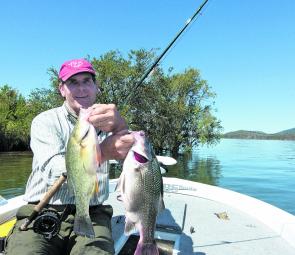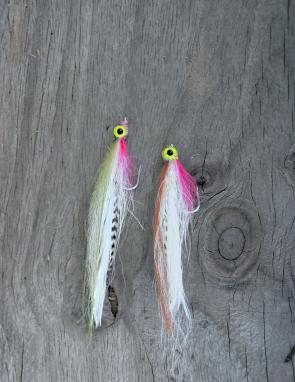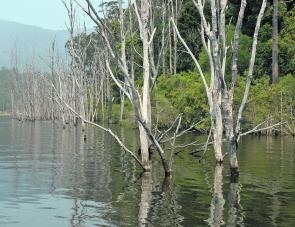When anglers look closely at the fishing in most of southern Queensland’s impoundments, all the attention seems to centre on bass, saratoga and barra.
Let’s face it, bass are undeniably the most popular as they are great fun on any tackle, but there’s another fish stocked in almost every dam between Gladstone and the Queensland border that also figures in catches but is not often targeted by lure anglers let alone fly anglers.
I’m referring to the good old golden perch, or yellowbelly, one of the native fish that always finds its way onto capture sheets whenever inland fishing competitions are held but which are now, thanks to the efforts of dedicated stocking groups, pretty well established in all of the sweetwater impoundments from Gin Gin’s Monduran Dam to Hinze Dam on the Gold Coast
Before putting that fly rod together and heading straight out to have a crack at a golden on fly, let’s look at the reasons to why these fish are not so prominent in catches in our popular impoundments. After all, there are always plenty of anglers on the water all year round with tantalising lures, plastics, vibes, and of course flies all trying for bass or another chosen native fish, but, usually with not many goldens coming to the net.
There are a couple of factors involved and we’ll take Somerset Dam (where the fish in the photos were caught) as a case study. In Somerset, where boats are virtually mandatory for fishing, most bass anglers either rely on their sounders to locate a school of bass prior to casting that first offering into the depths or troll slowly over the deeper water around the points and Stanley River’s submerged bed waiting for a rod to kick into life.
Those are great tactics for bass angling but are not going to be very productive for golden perch. While there’s always a chance of taking one feeding with bass, most goldens seem to have a preference for sitting in ambush mode close to cover or hard structure in shallower sections of the impoundment, which is a lot closer to the edges.
Put simply, if goldens are the fly rod target the boat needs to move away from the deeper water sections so the fly angler can work the fly in quite close to the bank with the most productive method being to cast in towards the bank from a short distance out, allow the fly to sink nearly to the bottom and then retrieved it in lively manner likely to interest a golden perch.
Goldens can be shy critters at times so the use of an electric motor is virtually mandatory in order to get close enough to a selected area for the fly to be successful. Remember, this will be shallow water fishing, likely less than 5m depth most times. Stealth is paramount and timing the attack is important too.
My experience has been that goldens are far more active at times of indirect sunlight, so getting on the water as early as possible is important. Likewise, shaded areas of an early morning are excellent places to make a start on these great fish. Naturally, a late afternoon fishing session with the sun behind a hill or deep cloud cover will also be a lot more productive for goldens than working the fly in the middle of the day when the sun is at its brightest.
There is another factor to consider as well. Goldens have small mouths when compared to the likes of bass or saratoga so it follows that a smaller fly will be more successful with size 1 or 2 ideal. Purple and black Bass Vampires, Red Vamps and Clousers in chartreuse over white will attract yellowbelly but my favourite fly is a small size 1 or 2 Deceiver, in plenty of white bucktail with a small section of brown or pale green along the top. Don’t forget the small splash of red under the gill area if you make your own flies.
These fish often tend to pick at an offering before a hook up is achieved. On quite a few occasions I’ve had goldens pick two, three or even more times at a fly prior to some solid weight being transmitted down to the rod butt. The smart tactic is to just keep the steady ‘strip-pause-strip-pause’ retrieve going while the fish is giving the fly some attention. Sooner or later the hook will take a hold and the fun will begin. On fly tackle, golden perch give a good account of themselves. They can grow quite large in impoundments and fish up to 60cm or more common than you think.
Anything you’d feel comfortable using for bass would be fine for goldens, with a 6-8wt fly outfit being ideal. But instead of a very fast sink fly line, I’d suggest an intermediate sink rate line or maybe even a sink tip one in lieu. The idea it to get the fly in close, near some chosen cover, a bit of sheer bank or a small inlet then allow it to sink somewhat on a tight line, which is important, before commencing the strip back to the boat. Goldens will often hit the fly on the drop.
The best part is that these exact same tactics will also work for the other inhabitants of the impoundment taking it easy in the same area so there’s likely to be action all round. Mixed bags of native fish on the fly rod? I can’t see anything wrong with that!
If you plan to eat that big golden taken on the fly, give the fillet a night in the fridge so the fat section atop the fillet shows up prominently and can be easily removed with a knife. Goldens are good tucker, ask any old timer from west of the ranges.
Can they be caught in our western rivers? Absolutely, if there’s around 40cm of stream visibility and there’s room to get a fly rod into action, goldens are a lot of fun, the by-catch here often being cod.
As we approach the cooler months, bass fishing will crank up in the impoundments so if the bass are a bit elusive go for gold instead. You might be surprised to see how easy it is.
.
Reads: 6757
The author with a mixed bag of natives, a golden perch and a bass taken from a shallow bank in Somerset Dam.

Denise Kampe with a top quality Somerset Dam golden. This fish was taken on fly right next to the southern boat ramp at old Kirkleigh (Somerset Park) while we were waiting for our turn to pull the boat out.

A couple of the author’s favourite golden perch flies: small Leftys Deceivers.

Standing timber in Borumba Dam. Sections like this offer the fly angler a chance of both saratoga and golden perch.

This looks pretty gnarly but if the fly can get in there a golden will likely latch onto it.

Sloping bank such as this section are worth a try for goldens at first light or late of an afternoon.




